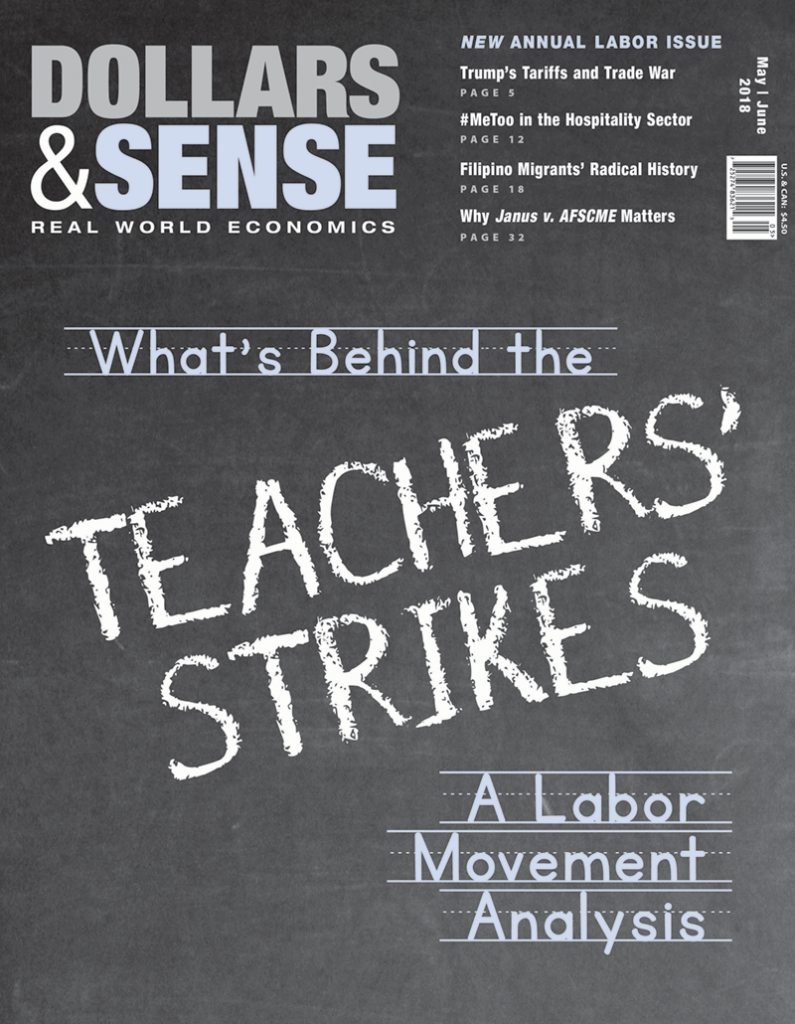
Our May/June 2018 issue, which is our Annual Labor Issue, has been sent to subscribers, and we've posted several articles from it to our website, including David Bacon's How Filipino Migrants Gave the Grape Strike
Its Radical Politics, Ellen David Friedman's What’s Behind the Teachers’ Strikes, and (posted today), the first installment of Jane Paul's series "A Sustainable Economy Rises in Los Angeles," Financing a Sustainable Economy in Los Angeles.
Here is the page-two editorial note from this issue:
With this issue, we move our Annual Labor Issue from September/October to May/June—or, as we have been telling people, from the bosses’ Labor Day to where it belongs: near May 1st, which is celebrated almost everywhere besides the United States as International Workers’ Day.
Our cover story, by veteran labor organizer Ellen David Friedman, looks at the biggest story in the U.S. labor movement today—the teachers’ strikes that have caught fire in West Virginia, Oklahoma, Kentucky, Arizona, and Colorado. The strikes caught many people by surprise because they are happening in “red” states with relatively weak unions and labor rights. But GOP austerity policies in those states have squeezed public-sector workers, and teachers in particular, for years; the strikes are a response by teachers who have reached a breaking point. Friedman analyzes the insurgency as the last recourse teachers have when politicians and labor bureaucrats have failed them. But this “movement moment” also includes the growing democratic rank-and-file caucuses in the blue states, like the one that took over the Chicago Teaches’ Union, which are linking up with likeminded teachers in the red states.
Public-sector workers are about to feel yet another squeeze—from the expected U.S. Supreme Court ruling in in Janus v. AFSCME Council 31. That ruling, which could come by early summer, is likely to eliminate the requirement that workers who don’t want to join an existing union have to pay an agency fee for the collective bargaining services that the union provides. In his “Economy in Numbers” column in this issue, Gerald Friedman provides some background to Janus, including the precipitous rise of public-sector unions in the 1960s and ’70s; the steady rate of unionization in the public sector since then, even as the rate in the private-sector has fallen; and the fact that women, African Americans, and Latinos are disproportionately likely to work in the public sector and to be in public-sector unions. These groups will be affected most by Janus, but the ruling will also undermine the positive pressure public-sector unions have on wages and pensions for all workers.
As is the case in teaching, women are also represented disproportionately in the hospitality sector. Economist Ellen Mutari’s feature in this issue examines how that affects the dynamics of sexual harassment in the sector, with a focus on casino workers. Mutari emphasizes how intersecting institutionalized power structures of gender, race, and class are key to understanding workplace harassment and how it differs from sector to sector. Collective action, including militant action through unions and through organizations like the Restaurant Opportunities Center United, will be key to moving the #MeToo movement from a hashtag/media phenomenon focused on Hollywood to a robust social movement encompassing industries with lower-wage workers.
History holds important lessons about the importance of labor militancy. As Jane Slaughter noted recently in Labor Notes, the striking teachers in West Virginia wore red bandanas in homage to that state’s heritage of militant organizing among coal miners. Similarly, David Bacon’s feature on the role of militant Filipino activists in the history of the famous grape strike of the late 1960s credits the activists for keeping a legacy of labor militancy alive through another period of reaction, the Cold War.
Also in this issue: John Millerlooks at the Wall Street Journal’s criticisms of Trump’s tariffs and the resulting trade war with China and outlines a progressive alternative to both Trump’s trade chaos and the Journal’s free-market trade policies; Arthur MacEwan responds to a reader’s question about what regional wage variations mean for the proposal to raise the minimum wage to $15/hour; we begin a new series by teacher and community activist Jane Paul on efforts to build a sustainable economy in Los Angeles; and more!
We are very pleased to announce that <em>Dollars & Sense</em> has a new co-editor, Nick Serpe! Nick worked for several years as an editor at our comrade publication, <em>Dissent</em> magazine, and more recently did graduate work in economic history at Columbia University, where he studied the political economy of Silicon Valley. He brings extensive experience in editing and left publishing and also a passion for labor organizing and left political activism. Welcome, Nick!</blockquote>
</body></html>